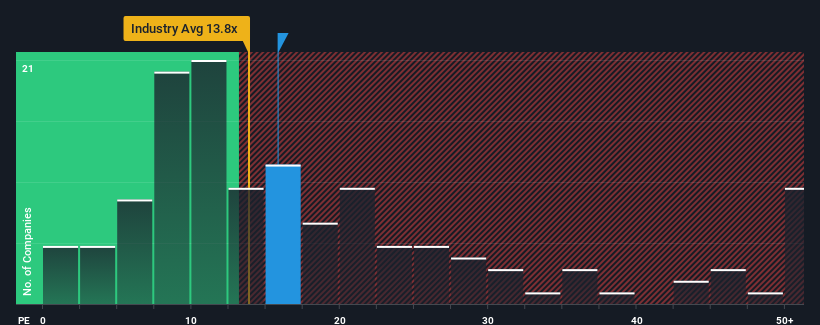Stock Analysis
- Hong Kong
- /
- Transportation
- /
- SEHK:2418
What Deewin Tianxia Co., Ltd's (HKG:2418) P/E Is Not Telling You

With a price-to-earnings (or "P/E") ratio of 15.8x Deewin Tianxia Co., Ltd (HKG:2418) may be sending very bearish signals at the moment, given that almost half of all companies in Hong Kong have P/E ratios under 9x and even P/E's lower than 5x are not unusual. Although, it's not wise to just take the P/E at face value as there may be an explanation why it's so lofty.
For instance, Deewin Tianxia's receding earnings in recent times would have to be some food for thought. One possibility is that the P/E is high because investors think the company will still do enough to outperform the broader market in the near future. If not, then existing shareholders may be quite nervous about the viability of the share price.
See our latest analysis for Deewin Tianxia

How Is Deewin Tianxia's Growth Trending?
In order to justify its P/E ratio, Deewin Tianxia would need to produce outstanding growth well in excess of the market.
If we review the last year of earnings, dishearteningly the company's profits fell to the tune of 43%. The last three years don't look nice either as the company has shrunk EPS by 70% in aggregate. Therefore, it's fair to say the earnings growth recently has been undesirable for the company.
In contrast to the company, the rest of the market is expected to grow by 21% over the next year, which really puts the company's recent medium-term earnings decline into perspective.
In light of this, it's alarming that Deewin Tianxia's P/E sits above the majority of other companies. Apparently many investors in the company are way more bullish than recent times would indicate and aren't willing to let go of their stock at any price. There's a very good chance existing shareholders are setting themselves up for future disappointment if the P/E falls to levels more in line with the recent negative growth rates.
The Final Word
It's argued the price-to-earnings ratio is an inferior measure of value within certain industries, but it can be a powerful business sentiment indicator.
Our examination of Deewin Tianxia revealed its shrinking earnings over the medium-term aren't impacting its high P/E anywhere near as much as we would have predicted, given the market is set to grow. When we see earnings heading backwards and underperforming the market forecasts, we suspect the share price is at risk of declining, sending the high P/E lower. Unless the recent medium-term conditions improve markedly, it's very challenging to accept these prices as being reasonable.
There are also other vital risk factors to consider and we've discovered 5 warning signs for Deewin Tianxia (2 are concerning!) that you should be aware of before investing here.
If these risks are making you reconsider your opinion on Deewin Tianxia, explore our interactive list of high quality stocks to get an idea of what else is out there.
Valuation is complex, but we're helping make it simple.
Find out whether Deewin Tianxia is potentially over or undervalued by checking out our comprehensive analysis, which includes fair value estimates, risks and warnings, dividends, insider transactions and financial health.
View the Free AnalysisHave feedback on this article? Concerned about the content? Get in touch with us directly. Alternatively, email editorial-team (at) simplywallst.com.
This article by Simply Wall St is general in nature. We provide commentary based on historical data and analyst forecasts only using an unbiased methodology and our articles are not intended to be financial advice. It does not constitute a recommendation to buy or sell any stock, and does not take account of your objectives, or your financial situation. We aim to bring you long-term focused analysis driven by fundamental data. Note that our analysis may not factor in the latest price-sensitive company announcements or qualitative material. Simply Wall St has no position in any stocks mentioned.

Simply Wall St
About SEHK:2418
Deewin Tianxia
Deewin Tianxia Co., Ltd provides logistics and supply chain, financial, and internet of vehicles (IoV) data services in the People’s Republic of China.
Mediocre balance sheet second-rate dividend payer.
